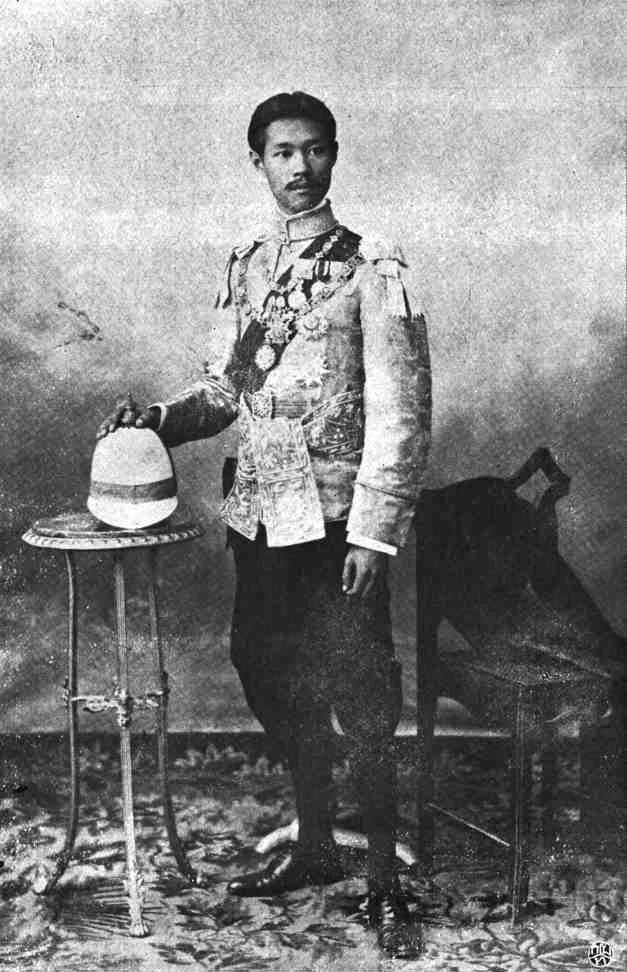
ลาวดวงเดือน
Lao Duang Duen
ภาพ: วัดร่องขุ่น จังหวัดเชียงราย ประเทศไทย
Image: Wat Rong Khun, Chiang Rai, Thailand
Origin: Thailand
Language: Thai
ลาวดวงเดือน
พระเจ้าบรมวงศ์เธอ กรมหมื่นพิไชยมหินทโรดม
โอ้ละหนอดวงเดือนเอย
พี่มาเว้ารักเจ้าสาวคำดวง
โอ้ว่าดึกแล้วหนอพี่ขอลาล่วง
อกพี่เป็นห่วงรักเจ้าดวงเดือนเอย
ขอลาแล้วเจ้าแก้วโกสุม
พี่นี้รักเจ้าหนาขวัญตาเรียม
จะหาไหนมาเทียม โอ้เจ้าดวงเดือนเอย
หอมกลิ่นเกษร กษรดอกไม้
หอมกลิ่นคล้ายคล้ายเจ้าสูเรียมเอย
หอมกลิ่นกรุ่นครันหอมนั้นยังบ่เลย
เนื้อหอมทรามเชยเอ๋ยเราละหนอ
Lao Duang Duen
Oh-la-naw duang-duen euy
Phi ma wau rak jau-sau kham-duang
Oh deuk laew naw phi khaw la-luang
Ok-phi pen huang rak jau duang-duen euy
Khaw la laew jau kaeu go-sum
Phi ni rak jau naw kwan ta-riam
Ja haa nai ma tiam aw jau duang-duen euy
Hom glin gaesawn, gaesawn dok-mai
Hom glin khlai, khlai jau su riam euy
Hom glin grun gran hom nan yang baw loei
Neua hom sam choei euy rau la-naaw
The Moon
Music: Benbadhanabongse, Prince of Phichai
Oh, my beloved moon
I’ve come to say I love you
It is already late, may I must say farewell
My heart is anxious, I really love you, my moon
May I say goodbye, princess?
I love you, lady, with all my soul
Where can I find your equal, moon princess?
The smell of jasmine
It is similar to you
The fragrance is strong, it still reminds me of you
My lady’s skin is fragrant
A story of royal love
Lao Duang Duen was written by the Prince of Phichai, Benbadhanabongse (13 September 1884 – 11 November 1909) (pronounced: pen-patana-pohng, /pʰɛnpʰatʰana'pʰong/).
He was the 41st child and the 38th son of King Chulalongkorn (Rama V).
Benbadhanabongse was very musically inclined and was said to be able to play a wide variety of traditional Thai musical instruments.
At one point in his life, he visited the Kingdom of Chiang Mai (present day Northern Thailand) with an entourage where he met Princess Chomchuen. They fell in love, but Princess Chomchuen's father refused to allow his daughter to marry a Siamese prince.
Heartbroken, Benbadhanabongse returned to Siam and penned this song, with the title Lao Damnoen Kwaen in 1903. He was reported to have performed this song whenever he missed the princess. After his death shortly after in 1909, the song became a symbol of lost love and romance in Thailand.
Over time, the name of the song became more widely known as Lao Duang Duen, referencing the opening words in the song.
Prince of Phichai, Benbadhanabongse (1884-1909), author of Lao Duang Duen
Image by unknown author - Bureau of the Royal Household, Kingdom of Thailand, Public Domain, https://commons.wikimedia.org/w/index.php?curid=7834175
Lao elements in Lao Duang Duen
Owing to its position in Southeast Asia, Thailand became a crossroads where many cultures meet. Cefkin (2018) suggests because of this, Thai society accepts ideas from their neighbours easily.
Curiously, 'indicators of foreignness', as Cefkin puts it, can even be found throughout Lao Duang Duen. Most immediately is the prefix Lao in the name of the song, in reference to the culture associated with the present-day Laos. Indeed, Benbadhanabongse makes use of several musical allusions to Lao traditional music, as well as words in Lao in Lao Duang Duen. These are:
โอ้ละหนอ Oh-la-naw (Vocables imitating opening recitatives in Lao folk music)
เว้า Wau (Lao word, meaning to say)
ลา Laa (Lao word, meaning to say goodbye)
The use of Lao words and musical elements is likely an allusion to Princess Chomchuen's native tongue.
Pha That Luang, a national symbol of Laos
Lao Duang Duen is shared across different cultures in Southeast Asia, and versions of the melody can be heard in Laos and Cambodia as well.
In Thailand and Laos, Lao Duang Duen is usually accompanied with a mixed-gender dance. There are some differences in the presentation of the song between these two cultures. The most obvious difference is the language, where the Lao version is sung in Lao. Furthermore, in the second embed video, the Laoness of the interpretation is further strengthened by the use of Lao clothing, especially in the women's dresses.
That said, perhaps because of the close affinities between Thai and Lao cultures, Cefkin (2018) notes that Lao commentators would assert Lao Duang Duen as a Lao traditional song with traditional elements, but also acknowledge the compositional origin as Thai.
Cambodia also has a version of Lao Duang Duen which is referred to as Reaksmey Duong Chan. The melody is very similar and is acknowledged to be influenced by Lao Duang Duen, but is generally considered to be a new Khmer dance drawing from older forms classical dance. In Cambodia, this is a women-only dance, as opposed to the mixed-gender dance routine seen in Thailand and Laos.
Lao Duang Duean in Thai
Lao Duang Duean in Lao
Reaksmey Duong Chan, the Khmer version of Lao Duang Duean
References
Cefkin, B. P., (2018) '"Lao Duang Duen" Lost in Translation: A New Perspective on the Southeast Asian Classical Arts', American Music Research Center, 27(1), pp. 25-40.


